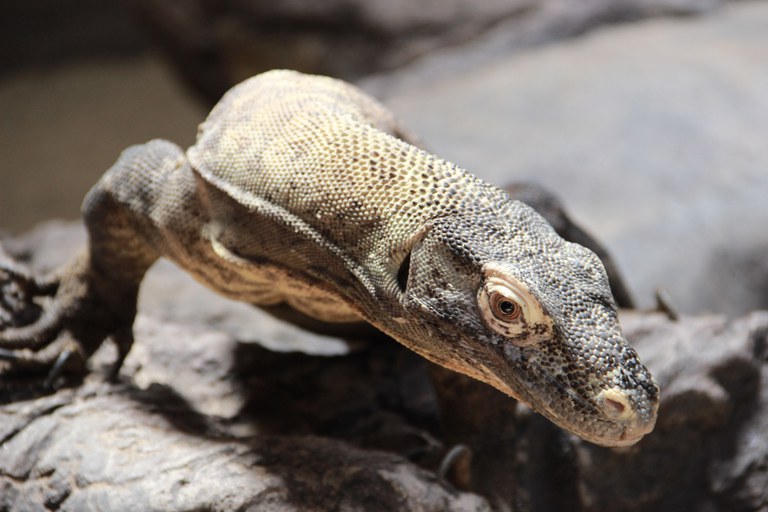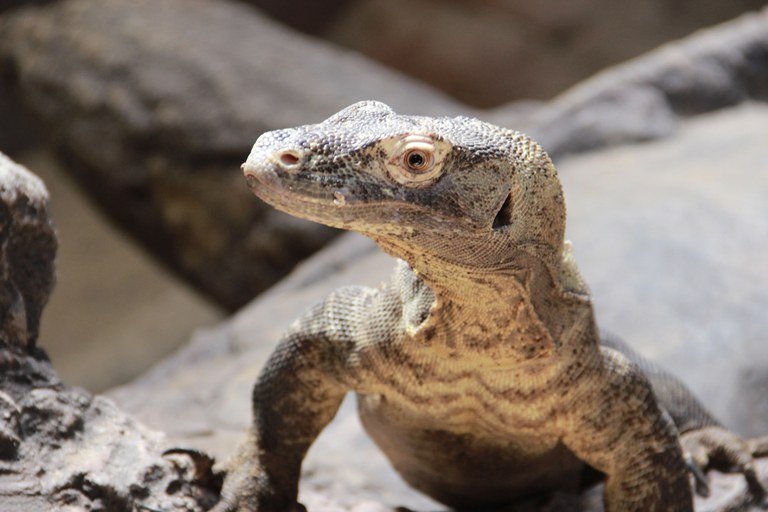Komodo Dragons
Goal
Identify unique adaptations that Komodo dragons have.
Introduction to Animal

While Komodo dragons don’t have wings or breathe fire like their mythical counterparts, they are still considered to be king of the lizards. Komodo dragons are the largest lizard species in the world, with females growing over 6 feet long and males getting as big as 10 feet. Their large size and mouthful of 60 sharp teeth make them excellent at hunting their food, which is only meat. As carnivores and predators Komodo dragons will hunt and eat smaller lizards and water buffalo, and everything in between. Komodo dragons’ saliva contains deadly bacteria, so if their prey gets away they’ll just follow it at a leisurely pace until the animal succumbs to an infection. Komodo dragons will eat fresh meat, but if they come across an animal carcass, they will likely eat that too. Komodo dragons are providing an ecosystem service by eating these carcasses; it helps prevent the spread of disease and promote overall ecosystem health.
These large lizards are only found on five Indonesian islands, and dragons are well adapted for island living. Their scales are green on top with yellow underneath, making for excellent camouflage to hide from their predators when they are young and their prey when they are older. Komodo dragons are also excellent swimmers with the ability to travel from island to island. On top of swimming, they can also run at speeds of 13 miles per hour! Now, if only they could ride a bike, they would be ready for a triathlon!
Even when considering their deadly saliva and swimming skills, the most impressive adaptation that Komodo dragons have is their ability to reproduce. Most often, one male and one female will come together for reproduction. The female lays 15-30 eggs in her nest and covers them up. However, scientists have observed some females reproducing on their own, laying a clutch of eggs without the help from males. This form of reproduction is called parthenogenesis. Komodo dragons are not the only animal that can reproduce this way. Different species of sawfish, stick insects, and even whiptail lizards native to New Mexico, can reproduce through parthenogenesis.
Komodo Dragons at the ABQ BioPark
Currently the BioPark has one female Komodo dragon named Indah. Indah is still quite young and has a lot of growing to do. As a reptile, Komodo dragons have unique adaptations so that they can behave as adults do and care for themselves from the moment they hatch. So even though Indah might not be the biggest or baddest Komodo dragon out there, she is capable of hunting, hiding and caring for herself. While Indah doesn’t have to worry about predators at the ABQ BioPark, her size is a good advantage if she were living in the wild. Young Komodo dragons often climb trees as a way to stay safe from larger Komodo dragons and other predators that might be interested in eating them as a snack. If you are looking for Indah in the reptile house and can’t find her, try looking up in the trees. You may catch a glimpse of her tail.
One thing the BioPark provides for all of the animals is enrichment; something to keep them mentally and physically engaged and challenged. For our Komodo dragon this may include feeding whole carcasses such as rabbits, putting different scents in parts of her habitat, or even taking her on leashed walks with reptile keepers.
Komodo Dragon Conservation
 Kod
Kod
Indah hatched in 2013 and came to the BioPark in 2019 on a Species Survival Plan (SSP) recommendation. These recommendations are exactly what the name sounds like: a survival plan for species that are designed based off of individual animals' genetic backgrounds. The goal of SSPs is to diversify the genetics of animals in accredited zoos and aquariums across the United States. As an Association of Zoos and Aquariums (AZA) accredited facility, the BioPark is proud to be part of SSPs and works with other zoos and aquariums in all of our animal departments to provide the best home and care possible.
With sea levels rising through global climate change, the Komodo dragon’s habitat space is getting smaller and smaller. With less habitat space it's more challenging for dragons to claim and keep their territories and they have a harder time getting food. You can help Komodo dragons by limiting the amount of energy you use at home. This will limit the amount of greenhouse gases going into the atmosphere, which contribute to global climate change. Some things that you can do to help are playing a board game instead of video games, turning off the lights when you leave a room and taking the bus to school.
Activity: Lazy Lizard Home
While there might not be any Komodo dragons living in your backyard, there are lots of small lizards that live here in New Mexico! Lizards are an important part of our local food web; they’ll eat a lot of the insects that we might consider pests and are a food source for important predators such as owls, snakes and coyotes. You can create your own lazy lizard home to make your backyard a more desirable place for lizards, toads, and frogs to hang out and live. These critters like dark and damp areas, and by putting a lazy lizard home in your yard you are providing the perfect spot for them.
Activity Materials
- Small cardboard box
- Scissors
- Non-toxic glue (optional)
- Sticks, leaves, grasses, pebbles or other organic material from your yard (optional)
- Non-toxic markers (optional)
- Non-toxic paint (optional)
Activity Procedure
- Create a door in your cardboard box by cutting a hole on the side.
- Decorate your lazy lizard home: you can do this by gluing on some grasses or leaves from your yard or decorating it using paints and markers in the color of your choice.
- Find a good place to put it: scope out your yard and find a shady area where you can put your lazy lizard home. You can keep it from being blown over by placing a rock inside your home.
Additional Resources
To find out more about Komodo dragons, explore the links below.
